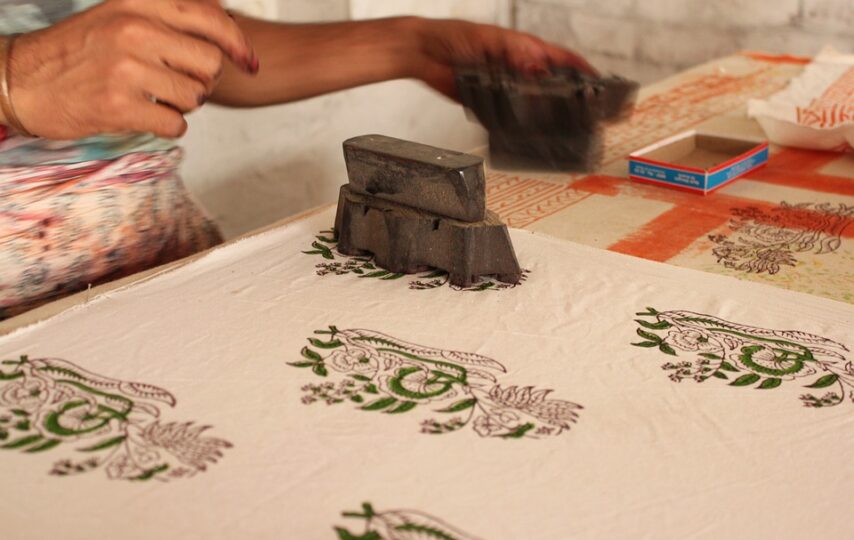Hand block printing is an ancient technique that has been practiced in India for centuries. It involves the use of carved wooden blocks to create beautiful patterns on fabrics. Traditional hand block printing techniques have been preserved over generations, but contemporary adaptations have also emerged in recent times.
Contemporary adaptations of hand block printing techniques are characterized by a blend of tradition and innovation. These adaptations have been driven by changes in design, technology, and consumer demand. While some of these adaptations have raised concerns about the preservation of traditional techniques, they have also expanded the reach and impact of the craft.
Digital printing is one of the contemporary adaptations that have impacted hand block printing. This technology has enabled the creation of intricate designs that were not possible with traditional techniques. Digital printing has also made it possible to produce fabrics in large quantities, reducing the time and cost involved in production. However, digital printing has also raised concerns about the impact on the environment and the authenticity of the craft.
Contemporary design has also influenced hand block printing techniques. Designers are experimenting with new patterns, colors, and materials, giving a modern twist to the traditional craft. This has led to the creation of unique designs that appeal to a broader audience. Contemporary designs have also enabled hand block printed fabrics to be used in a wider range of products, including maxi dresses, skirts, and bags.
Creative adaptations of hand block printing techniques have also emerged, with artisans using unconventional materials, experimenting with colors, and innovatively using traditional patterns. For example, some artisans are using organic materials such as bamboo and hemp to create hand block printed fabrics. Others are experimenting with colors, using natural dyes to create unique shades and textures. Innovative use of traditional patterns has also enabled artisans to create unique designs that appeal to contemporary consumers.
The significance of contemporary adaptations of hand block printing techniques can be seen in several ways. Firstly, they have helped to preserve traditional techniques by making them relevant to contemporary consumers. This has enabled the craft to remain relevant and sustainable in a rapidly changing fashion industry. Secondly, contemporary adaptations have expanded the reach of the craft by appealing to a wider audience, including those who may not have previously been interested in traditional hand block printed fabrics. Finally, contemporary adaptations have had an economic significance, providing employment to many artisans and driving the growth of the industry.
However, contemporary adaptations have also presented challenges and limitations. Authenticity and the preservation of traditional techniques have been a concern for many artisans and designers. Some have raised concerns that contemporary adaptations may lead to the dilution of traditional techniques, resulting in the loss of the craft’s cultural and historical significance. The impact of contemporary adaptations on the environment and sustainability has also been a concern, with digital printing and the use of unconventional materials raising questions about the long-term impact on the environment. Access to resources and training has also been a limitation for many artisans, especially those who may not have access to the latest technology or design trends.
Examples of contemporary adaptations of hand block printing techniques can be seen in the work of designers and artisans who have used the craft to create unique products. For example, some designers are using hand block printed fabrics to create contemporary maxi dresses that appeal to modern consumers. Others are using the craft to create products such as home decor items and accessories. The impact of contemporary adaptations on the industry can also be seen in the growth of small-scale enterprises and the development of cottage industries that provide employment to many artisans.
Conclusion:
Contemporary adaptations of hand block printing techniques have enabled the craft to remain relevant and sustainable in a rapidly changing fashion industry. While these adaptations have raised concerns about the preservation of traditional techniques and the impact on the environment, they have also expanded the reach and impact of the craft. Designers and artisans who use contemporary adaptations to create unique products, including maxi dresses, have played a critical role in the growth of the industry. It is important to balance tradition and innovation to ensure that the craft’s cultural and historical significance is preserved while also appealing to modern consumers. To achieve this, it is necessary to provide access to resources and training to all artisans and designers, regardless of their location or background. By doing so, we can ensure that the craft of hand block printing continues to thrive for generations to come.
As consumers, we can also play a role in supporting the hand block printing industry by choosing to buy products made using both traditional and contemporary techniques. By choosing to wear hand block printed clothing, including maxi dresses, we are not only supporting the preservation of this ancient craft but also promoting sustainability and empowering artisans and entrepreneurs.








